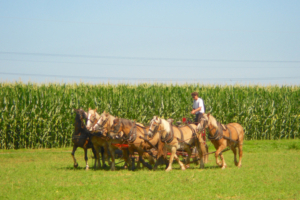
Farmers in Lancaster County, PA. Source
A researcher at Penn State University (PSU) is investigating temperature changes in the Northeast and how these changes will impact corn growth and development. Heather Karsten, associate professor of crop production ecology in Penn State’s College of Agricultural Sciences, used climate data and models from Syracuse, New York, State College, Pennsylvania, and Landisville, Pennsylvania to measure the projected impacts on corn farms. Their research was published in Plos One in June.
The Northeast U.S. is the fastest warming region in the country, and is a major producer of corn and dairy. Using downscaled projected climate data (2000-2100) from 9 models, their analysis showed that towards the end of the century there will be “fewer spring and fall freezes,” less time to maturity for corn plants, and more hot days above 95°F.
Climate change is expected to hit northeast corn production the hardest for two reasons. First, much of the country’s dairy production is in that area, which relies on corn for feed. Secondly, many models rank the Northeast as one of the fastest-warming regions, warming 5.4°F compared with a rise of 3.6°F globally by 2050.
Some management strategies such as planting earlier and installing irrigation systems could help offset the effects of temperature and drought. Their paper called for future research on more localized strategies to help farmers adapt at the regional level.
